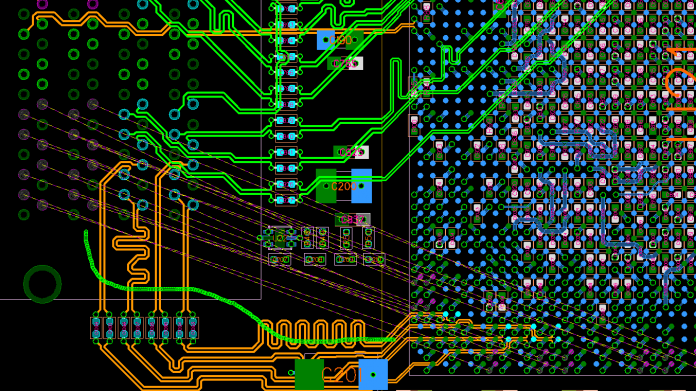Extra diode added
At the bottom of the scale, with almost all current flowing through the meter, the measurement tempco is low, being limited to the mechanical and magnetic temperature coefficients of the meter movement. At higher currents though, we are seeing the voltage across the diode, which of course decreases by about 2mV/K as predicted by the diode equation. This not only affects the slope of the log law, but also our linear-to-log transition point. In addition, the meter winding forms a significant part of the total series resistance, copper having a TCR of 3930ppm/K at room temperature. The resulting deflection vs. current curves shown in Figure 2 are for a 1N5817 at temperatures of 0°C, 25°C and 50°C. These account for the movement’s TCR as well as the tempco of the diode, but ignore any self-heating effects in the latter. At a fairly constant temperature there is no practical problem.
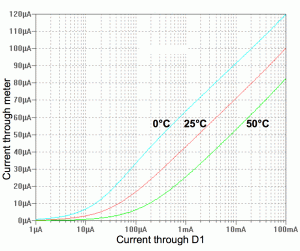
Self-heating, mainly in D1, is no real problem either. Let’s assume that 100mA is flowing and that D1 is dropping 400mV: that’s 40mW. The DO-41 1N5815 has a basic thermal resistance of 50K/W according to its data sheet–with longish leads and lots of heat-sinking copper. Putting these figures together shows that at 100mA, the junction will rise by just 2°, equivalent to a decrease in VF of about 4mV or about 1% error at full scale. Try to keep your diode’s leads short and your thermal masses high. Beware of high transient currents, perhaps at switch-on, as these will cause errors until the junction cools down again.
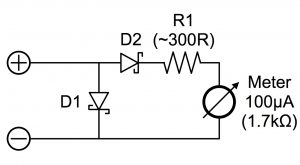
The improved version in Figure 3 nulls the tempco by adding an extra diode in series with the meter movement; its curves shown in Figure 4. Note that the bulk of the scale is now log-ish, the extra diode effectively suppressing the initial, linear region. However, the choice of diodes is now critical, as D2 should have a slightly lower forward voltage than D1 but matching characteristics otherwise. Confusing.
The role of LTspice
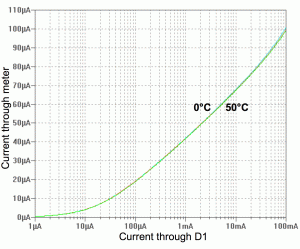
LTspice to the rescue! I hit on the combination of a 10MQ060N for D1 and a BAT54 for D2 by happy accident–it was the first pair I simulated. Both are cheap, available and modelled natively by LTspice, so they are therefore recommended. A pair of 10MQ060Ns works almost identically (but a pair of BAT54s doesn’t). Combinations of other devices mostly show worse temperature variations with kinkier indications, so model before you build. R1 could be omitted if the meter’s sensitivity and resistance are suitable. Couple D1 and D2 together thermally so they will track one another with temperature.
Silicon P-N junction diodes generally have very straight (log IF)/VF relationships; Schottkys don’t. This is due to their construction that has an inherently higher series resistance, causing the law to become more linear than log at very low currents and often also has guard rings to control potential gradients that can form P-N diodes paralleled with the Schottky junction itself, thus softening the curve at high currents. So in practice, the precise log law varies with current as well as device type. So while a junk-box diode may be fine for the first version–given that circuit’s unavoidable inaccuracies–careful selection is needed for the two-diode design. Schottky diode gives more background.
Because I have a box of cheap leftover edgewise 100μA/1700Ω indicators that fit 35mm x 14mm apertures, I use those. This type is very common and gives a compact, practical result, but their construction, linearity and consistency between units would make the ghost of Monsieur d’Arsonval weep.
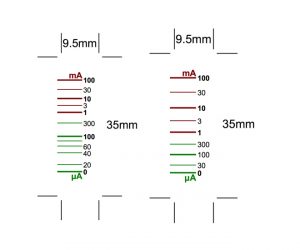
The calibration points used in Figure 5 were generated by arranging series combinations of the monitor, a battery, fixed and variable resistors, and a DMM. The existing meter scale was marked at suitable points, then removed and scanned, the scan being used as a template for the final layout. The simulation results were used to generate the datum points for Figure 6, but the results reflect reality well, despite the horrible meter. These scales will save you time but won’t be quite as accurate as making your own from scratch (obviously, other movements will need different scales). Adjust R1 to trim the calibration (the meter is specified as ±20%). Both scales take the movement’s nonlinearity into account.
Note that I call this a “monitor” rather than a “meter”; the latter term implies, to me, something with better accuracy. Nonetheless, I now build these into most of my development and even production test rigs, and very useful they are for spotting a variety of faults and problems, from shorted power traces to wrongly-coded pullup pins.
For the ultimate in current-monitoring simplicity, just put a suitable diode in series with your supply’s negative end and scope its forward voltage. After some Post-It note calibration, you can monitor your supply current in exact synchronisation with whatever else you want to probe.
Nick Cornford built his first crystal set at 10, and since then has been designing professional audio equipment, modems and numerous datacomm products. He is currently involved with technical security equipment, he is trying to retire.



